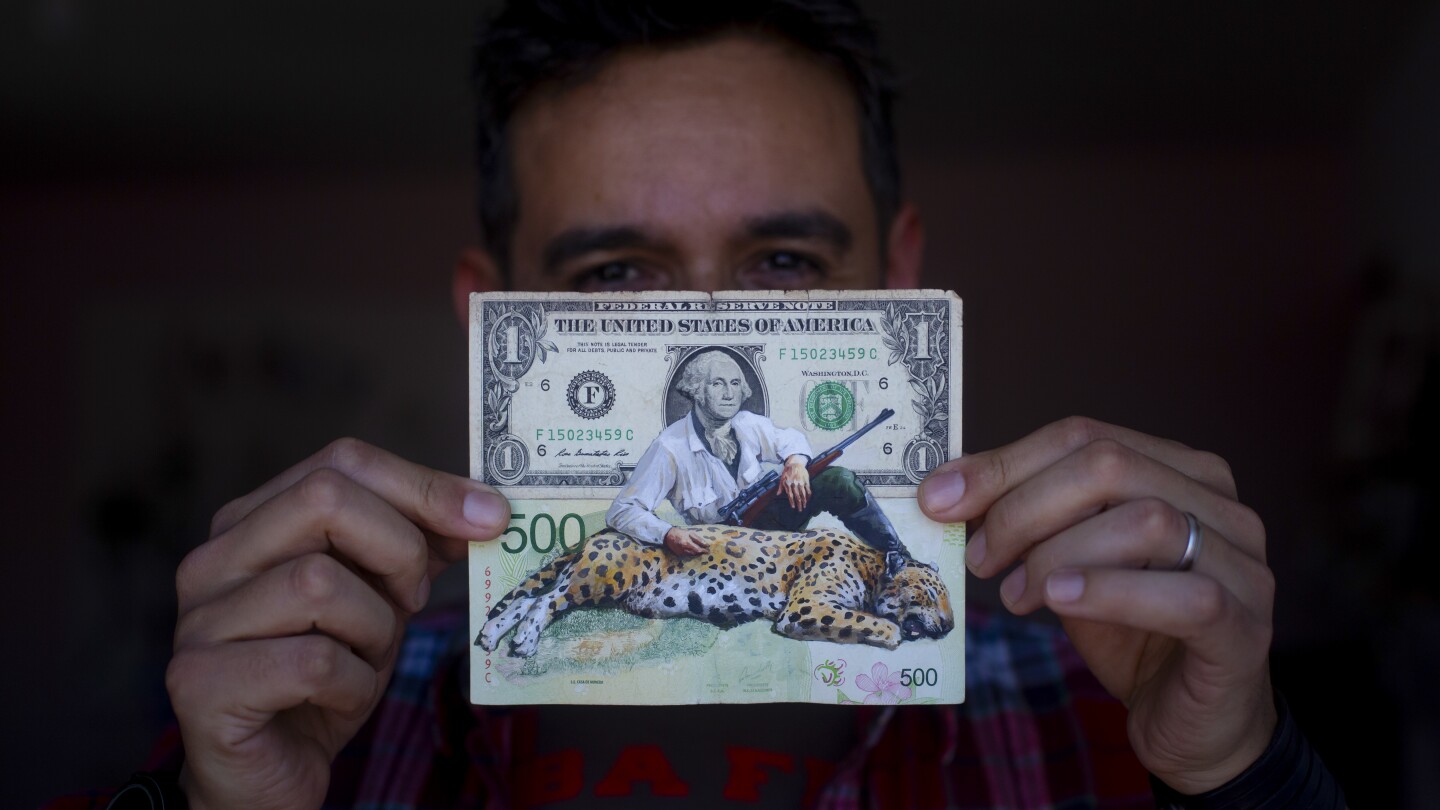BUENOS AIRES, Argentina (AP) — A jaguar lies beside George Washington. The United States’ first president holds a rifle with one hand as he rests the other on the dead Argentine predator.
The backdrop is a U.S. dollar and an Argentine 500-peso note joined like a book, a clear allusion to the rapid depreciation of the local currency, the peso. That has made it difficult for Argentines to make ends meet. The peso has depreciated around 60% compared to the U.S. dollar over the past year. It has occurred in parallel to one of the world’s highest inflation rates. Together, the economic travails have have bolstered an anti-establishment candidate who admires former President Donald Trump.
As millions of Argentines express dismay and anger, a group of artists is seeking to show the economic damage the best way they know how, with art. And as they express themselves, the artwork increases the value of the increasingly worthless bills they use as material.
It’s one of the starkest illustrations of how runaway inflation has taken its toll and is changing habits; from middle-class women giving up beauty-parlor visits to families buying secondhand clothes. Argentines with extra cash buy stockpiles of things they need, knowing prices are certain to rise next month.
The runaway inflation conversely means restaurants in the capital are packed, because there’s no point in saving when a paycheck loses purchasing power every month.
Artist Sergio Díaz and other Argentine artists’ Money Art movement uses moderately priced brushes and acrylics to paint banknotes of 10, 20, 100, or 1,000 pesos and then share their work on social media.
The artwork then fetches prices ranging from 40,000 to 70,000 pesos domestically and as much as $300 abroad. Stringent capital controls in Argentina mean that access to the official foreign exchange market is extremely limited, so parallel rates have flourished.
The artists are reclaiming the currency at a time when the bills have often been the target of disdain from Argentina’s neighbors. Brazilian soccer fans have torn up peso bills as a mockery to their Argentine rivals. In Paraguay, exchange offices have begun to reject Argentine pesos.
Inflation surged 12.4% in August from July, the highest rate of monthly consumer price increases since February 1991. Compared to August of last year, prices rose 124%, according to figures released Wednesday by the government’s Indec statistics agency.
Diaz will exhibit the piece in which Washington is shown with the jaguar, along with others from the series, “The Art of Devaluation,” in November in Salta, his hometown in northern Argentina.
“There is an element of transgression, of vandalism… but my idea is to go beyond that and transform the bills while addressing the issue of inflation that affects us all,” explained Diaz.
The artist has painted portraits of Argentine soccer stars Diego Maradona and Lionel Messi on bills, along with the terrifying clown Pennywise from “It,” and characters from “Harry Potter,” among others.
He has also participated in Money Art exhibitions abroad and, along with other Argentine colleagues, maintains contact with Venezuelan artists who were pioneers in this form of art, as their country’s bills also suffered a sharp drop in value making many of them virtually worthless.
Fellow artist Cristian English began working on bills three years ago when, during the quarantine imposed due to the COVID-19 pandemic, he found it difficult to get canvases and used bank notes as a substitute.
The government unveiled a new 2,000-peso bill in May, and English called it “a 2,000-peso bill that’s worth nothing. It’s just printing for the sake of printing.”
English has received orders from fans in Paraguay and Chile, asking him to create one work he has made featuring Diego Maradona on a 10-peso bill, the number Maradona wore while playing for the national team.
English, 38, said that he has no plans to stop using the 2,000-peso bills for his art, in part because it’s much cheaper than the traditional canvas.
He complains, however, that it isn’t an easy material to work with because the paper is of a very low quality.
“What we’re going though is unparalleled,” he said.

